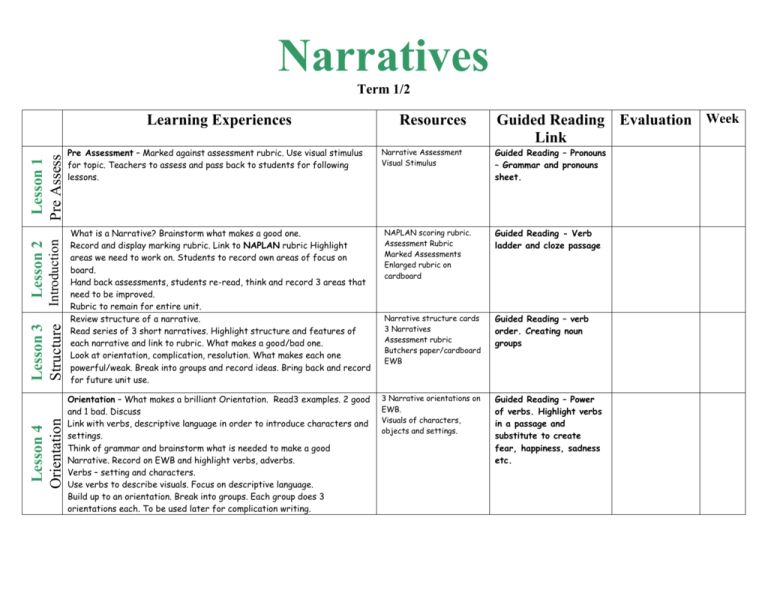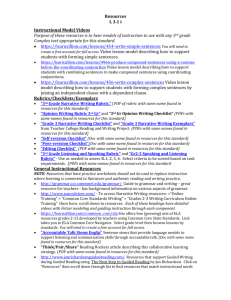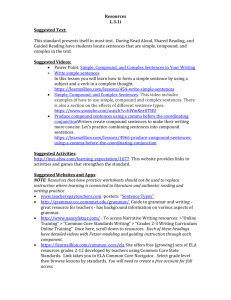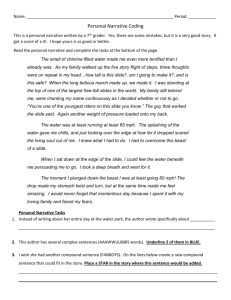Narratives
advertisement

Narratives Term 1/2 Introduction Lesson 4 Orientation Lesson 3 Structure Lesson 2 Lesson 1 Pre Assess Learning Experiences Pre Assessment – Marked against assessment rubric. Use visual stimulus for topic. Teachers to assess and pass back to students for following lessons. What is a Narrative? Brainstorm what makes a good one. Record and display marking rubric. Link to NAPLAN rubric Highlight areas we need to work on. Students to record own areas of focus on board. Hand back assessments, students re-read, think and record 3 areas that need to be improved. Rubric to remain for entire unit. Review structure of a narrative. Read series of 3 short narratives. Highlight structure and features of each narrative and link to rubric. What makes a good/bad one. Look at orientation, complication, resolution. What makes each one powerful/weak. Break into groups and record ideas. Bring back and record for future unit use. Orientation – What makes a brilliant Orientation. Read3 examples. 2 good and 1 bad. Discuss Link with verbs, descriptive language in order to introduce characters and settings. Think of grammar and brainstorm what is needed to make a good Narrative. Record on EWB and highlight verbs, adverbs. Verbs – setting and characters. Use verbs to describe visuals. Focus on descriptive language. Build up to an orientation. Break into groups. Each group does 3 orientations each. To be used later for complication writing. Resources Narrative Assessment Visual Stimulus Guided Reading Evaluation Week Link Guided Reading – Pronouns – Grammar and pronouns sheet. NAPLAN scoring rubric. Assessment Rubric Marked Assessments Enlarged rubric on cardboard Guided Reading - Verb ladder and cloze passage Narrative structure cards 3 Narratives Assessment rubric Butchers paper/cardboard EWB Guided Reading – verb order. Creating noun groups 3 Narrative orientations on EWB. Visuals of characters, objects and settings. Guided Reading – Power of verbs. Highlight verbs in a passage and substitute to create fear, happiness, sadness etc. Complication Lesson 5 Lesson 6 Resolution Lesson 7 Dialogue Lesson 8 Sentences Lesson 9 Simple Sentences Revision – Revise orientation. Provide a poor orientation and students are to rewrite. Complication – Revise what makes a good complication. Refer to previous brainstorm list. Brainstorm a list of well known narratives and their complications. Refer back to first 3 narratives read and link to brainstorm board. New groups are to write complications for each then rotate. Poor orientation example on EWB.3 -4 short narratives with complications 3 Narrative examples Guided Reading – proof reading and editing a text. Resolution – What makes a good resolution? Link back to the original 3 narratives read. Discuss what made them good. Were there resolutions good/bad? How does this affect the whole of the story? Focus on believability and relevance to beginning of the story. NO WAKING UP FROM DREAMS!!! Present class with a narrative needing a resolution. Complete together discussing all of the important things that make a resolution successful. In groups students are to complete their own unique resolutions. Look at communication between characters. How does it build relationships and/or change. Read 2 narratives and discuss how the characters and their relationships have grown. Link to NAPLAN rubric. Discuss how use of dialogue can display changes and growth within a character. Look at a large visual narrative and highlight all dialogue sentences. Transfer and discuss the numerous combinations used. Model how to write dialogue correctly. Record on board 3 Narrative examples EWB Half completed narrative – complication Cardboard/butchers paper Guided Reading – Resolutions – Students are to complete a resolution to a narrative, edit and publish. 2 Narrative examples EWB Large visual Narrative Cardboard and butchers paper Guided Reading – Dialogue. Editing and proof reading and other words than said. Sentences – Introduce students to the different sentences – Simple, Compound and Complex. Link to NAPLAN and points system. Discuss purpose and value of each. Link to editing and whether it is a complete message. Briefly cover each and provide a sheet of cardboard for each sentence. Record down all we know for each sentence on the cardboard. Add to later. 3 pieces of cardboard EWB NAPLAN rubric Assessment rubric Guided Reading – Dialogue Editing. Students to rewrite dialogue correctly then alter to change scared, happy, surpised. SIMPLE SENTENCES send a complete message. Are you sending a complete message? Stands alone, makes sense S+V+O Subject + Verb + Other (Object) Eg. The boy ran to the shops. Sentences are the foundations of paragraphs and text. If one sentence falls down then the paragraph won’t stand up. Re-read each and every sentence to ensure that it is sending a complete message. Model an array of sentences and have students discuss whether it is a proper simple sentence. Ask students what you want to do when you want to give more information? Link to compound sentences. EWB Simple sentence cardboard Variety of simple sentences Characters and setting Guided Reading – Simple Sentences – Make, edit and create simple sentences. EWB Compound sentence cardboard Variety of simple sentences Characters and setting Conjunction cardboard Guided Reading – Compound Sentences – Make, edit and create simple sentences. EWB Complex sentence cardboard Variety of simple sentences Characters and setting Conjunction cardboard NAPLAN point scoring Independent and dependent clauses Dependent clauses Guided Reading – Complex Sentences – Make, edit and create simple sentences. Editing and Proof Reading – Students receive a basic low scoring narrative. As a class mark it against the NAPLAN scoring rubric. As a group they need to highlight, underline and take notes on what is needed in order to improve it. Break off and re-write the narrative in groups. Switch completed Narratives and mark against the rubric. Basic Narrative on EWB and worksheet NAPLAN scoring rubric Cardboard Butchers paper Guided Reading – Rewrite a poor Narrative to improve its score. Lesson 12 Editing Lesson 11 Complex Sentences Lesson 10 Compund Sentences Revise simple sentences. Where would you use them? What effect do they have? COMPOUND SENTENCES. Introduce explain and discuss. Link to NAPLAN and point scoring system. Add 2 Simple sentences with conjunctions- and, so, but Eg. The boy ran to the shops and bought a bag of hot chips. Brainstorm conjunctions. Look at how conjunctions can alter the meaning of a compound sentence. Use a variety of simple sentences and link them using brainstormed conjunctions. Swap conjunctions and discuss how the sentence changes meaning. Students to complete examples as a group. Revise compound sentences. Where would you use them? What effect do they have? COMPLEX SENTENCES – Introduce, discuss and link to NAPLAN point scoring. Independent clause (does not stand alone) + dependent Clause(stands alone) eg the boy ran to the shops, thinking of the Anzacs. 2 Independent clauses eg the boy ran to the shops, Create a number of complex sentences using independent and dependent clauses. Have students add to a number of dependent causes to increase description and meaning.








